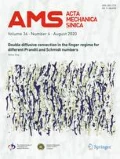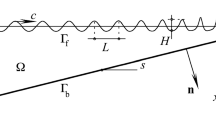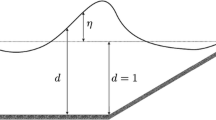Abstract
The early stages of a spilling breaking water wave leading to the formation of a bulge on the forward face of the wave are investigated. In this study, simultaneous space-time measurements of the free-surface elevation of a spilling breaking water wave are recorded and analyzed. The analysis, carried out in the frame of reference moving with the crest of the wave, reveals that the formation of the bulge is due to the presence of a shock-like mode. In the previous frame of reference, the shock itself is unsteady but its (spatial) location is time independent and coincides with the “toe” of the bulge. As time increases, the shock undergoes a flip (a reflection symmetry) with respect to the midpoint of our time interval. Such a flip is responsible for an abrupt increase of the wave steepness, which will lead to wave breaking at later times. Following these observations, we present a two-dimensional quantitative model which reproduces both the formation of the bulge and the sudden increase of the wave steepness.
Similar content being viewed by others
References
Galvin CJ. Breaker type classification on three laboratory beaches.J Geophys Res, 1968, 73(6): 3651–3659
Peregrine DH. Breaking waves on beaches.Ann Rev Fluid Mech, 1987, 89(8): 432–446
Longuet-Higgins MS, Cokelet ED. The deformation of steep surface waves on water.Proc R Soc London A, Math Phys Sci, 1976, 358(2): 1–26
New AL, Mclver P, Peregrine DH. Computations of overturning waves.J Fluid Mech, 1983, 15(4): 149–161
Duncan JH, Philomin V, Behres M, Kimmel J. The formation of spilling breaking water waves.Phys Fluids, 1994, 6(8): 2558–2560
Aubry N, Guyonnet R, Lima R. Spatio-temporal analysis of complex signals: theory and applications.J Statist Phys, 1991, 64(3/4), 683–739
Longuet-Higgins MS. Capillary-gravity waves of solitary type and envelope solitons on deep water.J Fluid Mech, 1993, 252(2): 703–711
Sirovich L. Turbulence and dynamics of coherent structures: I,II,III.Quart Appl Math, 1987, 5(1): 561–590
Wallace JM, Hussain F. Coherent structures in turbulent shear flows.Appl Mech Rev, 1990, 43(5): 203–209
Lumley JL. Coherent Structures in Turbulence. New York: Academic Press, 1981. 215–242
Longuet-Higgins MS. Shear instability in spilling breakers.Proc R Soc London A, Math Phys Sci, 1994, 446(3): 399–409
Longuet-Higgins MS. Crest instability of gravity waves. 1. The almost-highest wave.J Fluid Mech, 1994, 258(1): 115–129
Author information
Authors and Affiliations
Additional information
Supported by the Foundation of the State Education Commission of China
Rights and permissions
About this article
Cite this article
Zhongyuan, W., Aubry, N. & Duncan, J.H. The analysis of forming the bulge in a spilling water wave. Acta Mech Sinica 13, 26–35 (1997). https://doi.org/10.1007/BF02487828
Received:
Revised:
Issue Date:
DOI: https://doi.org/10.1007/BF02487828




